TREK-1 channels do not mediate nitrergic neurotransmission in circular smooth muscle from the lower oesophageal sphincter
- PMID: 20002101
- PMCID: PMC2825358
- DOI: 10.1111/j.1476-5381.2009.00531.x
TREK-1 channels do not mediate nitrergic neurotransmission in circular smooth muscle from the lower oesophageal sphincter
Abstract
Background and purpose: The ionic mechanisms underlying nitrergic inhibitory junction potentials (IJPs) in gut smooth muscle remain a matter of debate. Recently, it has been reported that opening of TWIK-related K(+) channel 1 (TREK-1) K(+) channels contributes to the nitrergic IJP in colonic smooth muscle. We investigated the effects of TREK-1 channel blockers on nitrergic neurotransmission in mouse and opossum lower oesophageal sphincter (LOS) circular smooth muscle (CSM).
Experimental approach: The effects of TREK-1 channel blockers were characterized pharmacologically in murine and opossum gut smooth muscle using conventional intracellular and tension recordings.
Key results: In LOS, L-methionine depolarized the resting membrane potential (RMP) but did not inhibit the nitrergic IJP. Cumulative application of theophylline hyperpolarized the RMP and inhibited the nitrergic IJP concentration dependently. The induced membrane hyperpolarization was prevented by pre-application of caffeine, but not by 1H-[1,2,4]oxadiazolo-[4,3-a]quinoxalin-1-one. 8-Br-cAMP significantly hyperpolarized membrane potential and increased the amplitude of the nitrergic IJP. In opossum LOS muscle strips, L-methionine increased resting tone but had no effect on nerve-mediated LOS relaxation. On the other hand, theophylline markedly inhibited tone. In CSM from mouse proximal colon, L-methionine caused modest inhibition of nitrergic IJPs.
Conclusions and implications: TREK-1 channels were not involved in the nitrergic IJP in LOS CSM. Not only does L-methionine have no effect on the nitrergic IJP or LOS relaxation, but the effect of theophylline appears to be due to interruption of Ca(2+)-releasing pathways (i.e. caffeine-like effect) rather than via blockade of TREK-1 channels.
Figures

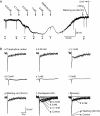
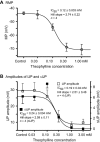

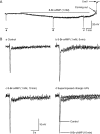


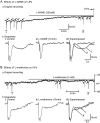
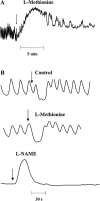
Similar articles
-
Ionic conductances regulating the excitability of colonic smooth muscles.Neurogastroenterol Motil. 2012 Aug;24(8):705-18. doi: 10.1111/j.1365-2982.2012.01956.x. Epub 2012 Jun 24. Neurogastroenterol Motil. 2012. PMID: 22726670 Free PMC article. Review.
-
Neurotransmission in lower esophageal sphincter of W/Wv mutant mice.Am J Physiol Gastrointest Liver Physiol. 2010 Jan;298(1):G14-24. doi: 10.1152/ajpgi.00266.2009. Epub 2009 Oct 22. Am J Physiol Gastrointest Liver Physiol. 2010. PMID: 19850967
-
Relative contribution of SKCa and TREK1 channels in purinergic and nitrergic neuromuscular transmission in the rat colon.Am J Physiol Gastrointest Liver Physiol. 2012 Aug 1;303(3):G412-23. doi: 10.1152/ajpgi.00040.2012. Epub 2012 May 24. Am J Physiol Gastrointest Liver Physiol. 2012. PMID: 22636169
-
Nitrergic prejunctional inhibition of purinergic neuromuscular transmission in the hamster proximal colon.J Neurophysiol. 2003 May;89(5):2346-53. doi: 10.1152/jn.00686.2002. J Neurophysiol. 2003. PMID: 12740397
-
[TREK-1: a potential target for novel antidepressants].Nihon Shinkei Seishin Yakurigaku Zasshi. 2007 Aug;27(4):147-51. Nihon Shinkei Seishin Yakurigaku Zasshi. 2007. PMID: 17879592 Review. Japanese.
Cited by
-
Ionic conductances regulating the excitability of colonic smooth muscles.Neurogastroenterol Motil. 2012 Aug;24(8):705-18. doi: 10.1111/j.1365-2982.2012.01956.x. Epub 2012 Jun 24. Neurogastroenterol Motil. 2012. PMID: 22726670 Free PMC article. Review.
-
Nitric oxide and its role as a non-adrenergic, non-cholinergic inhibitory neurotransmitter in the gastrointestinal tract.Br J Pharmacol. 2019 Jan;176(2):212-227. doi: 10.1111/bph.14459. Epub 2018 Sep 3. Br J Pharmacol. 2019. PMID: 30063800 Free PMC article. Review.
-
Gastrointestinal motility and its enteric actors in mechanosensitivity: past and present.Pflugers Arch. 2015 Jan;467(1):191-200. doi: 10.1007/s00424-014-1635-7. Epub 2014 Nov 5. Pflugers Arch. 2015. PMID: 25366494 Review.
-
CaMKII inhibition hyperpolarizes membrane and blocks nitrergic IJP by closing a Cl(-) conductance in intestinal smooth muscle.Am J Physiol Gastrointest Liver Physiol. 2012 Jul 15;303(2):G240-6. doi: 10.1152/ajpgi.00102.2012. Epub 2012 Apr 26. Am J Physiol Gastrointest Liver Physiol. 2012. PMID: 22538403 Free PMC article.
References
-
- Bennett MR. Non-adrenergic non-cholinergic (NANC) transmission to smooth muscle: 35 years on. Prog Neurobiol. 1997;52:159–195. - PubMed
-
- Crist JR, He XD, Goyal RK. Chloride-mediated inhibitory junction potentials in opossum esophageal circular smooth muscle. Am J Physiol. 1991a;261:G752–G762. - PubMed
-
- Crist JR, He XD, Goyal RK. Chloride-mediated junction potentials in circular muscle of the guinea pig ileum. Am J Physiol. 1991b;261:G742–G751. - PubMed
Publication types
MeSH terms
Substances
Grants and funding
LinkOut - more resources
Full Text Sources
Miscellaneous

